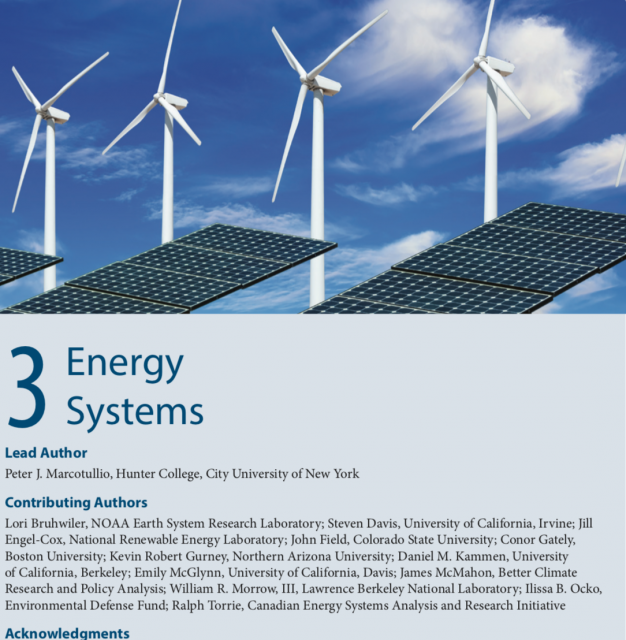NEWS RAEL contributes to Chapter 3: Energy systems. In State of the Carbon Cycle Report (SOCCR2): A Sustained Assessment Report for the United States
To access the Energy Sector chapter, click here.
KEY FINDINGS
- In 2013, primary energy use in North America exceeded 125 exajoules,1 of which Canada was respon- sible for 11.9%, Mexico 6.5%, and the United States 81.6%. Of total primary energy sources, approxi- mately 81% was from fossil fuels, which contributed to carbon dioxide equivalent (CO2e)2 emissions lev- els, exceeding 1.76 petagrams of carbon, or about 20% of the global total for energy-related activities. Of these emissions, coal accounted for 28%, oil 44%, and natural gas 28% (very high confidence, likely).
- North American energy-related CO2e emissions have declined at an average rate of about 1% per year, or about 19.4 teragrams CO2e, from 2003 to 2014 (very high confidence).
- The shifts in North American energy use and CO2e emissions have been driven by factors such
as 1) lower energy use, initially as a response to the global financial crisis of 2007 to 2008 (high confidence, very likely); but increasingly due to 2) greater energy efficiency, which has reduced
the regional energy intensity of economic production by about 1.5% annually from 2004 to 2013, enabling economic growth while lowering energy CO2e emissions. Energy intensity has fallen annu- ally by 1.6% in the United States and 1.5% in Canada (very high confidence, very likely). Further factors driving lower carbon intensities include 3) increased renewable energy production (up 220 peta- joules annually from 2004 to 2013, translating to an 11% annual average increase in renewables) (high confidence, very likely); 4) a shift to natural gas from coal sources for industrial and electricity production (high confidence, likely); and 5) a wide range of new technologies, including, for example, alternative fuel vehicles (high confidence, likely). - A wide range of plausible futures exists for the North American energy system in regard to carbon emissions. Forecasts to 2040, based on current policies and technologies, suggest a range of carbon emissions levels from an increase of over 10% to a decrease of over 14% (from 2015 carbon emissions levels). Exploratory and backcasting approaches suggest that the North American energy system emissions will not decrease by more than 13% (compared with 2015 levels) without both technological advances and changes in policy. For the United States, however, decreases in emissions could plausibly meet a national contribution to a global pathway consistent with a target of warming to 2°C at a cumu- lative cost of $1 trillion to $4 trillion (US$ 2005).
Note: Confidence levels are provided as appropriate for quantitative, but not qualitative, Key Findings and statements.
Contributing Authors
Peter J. Marcotullio, Hunter College, City University of New York (lead author)
Lori Bruhwiler, NOAA Earth System Research Laboratory; Steven Davis, University of California, Irvine; Jill Engel-Cox, National Renewable Energy Laboratory; John Field, Colorado State University; Conor Gately, Boston University; Kevin Robert Gurney, Northern Arizona University; Daniel M. Kammen, University
of California, Berkeley; Emily McGlynn, University of California, Davis; James McMahon, Better Climate Research and Policy Analysis; William R. Morrow, III, Lawrence Berkeley National Laboratory; Ilissa B. Ocko, Environmental Defense Fund; Ralph Torrie, Canadian Energy Systems Analysis and Research Initiative.
Recommended Citation for Chapter:
Marcotullio, P. J., L. Bruhwiler, S. Davis, J. Engel-Cox, J. Field, C. Gately, K. R. Gurney, D. M. Kammen,
E. McGlynn, J. McMahon, W. R. Morrow, III, I. B. Ocko, and R. Torrie, 2018: Chapter 3: Energy systems. InSecond State of the Carbon Cycle Report (SOCCR2): A Sustained Assessment Report [Cavallaro, N., G. Shrestha, R. Birdsey, M. A. Mayes, R. G. Najjar, S. C. Reed, P. Romero-Lankao, and Z. Zhu (eds.)]. U.S. Global Change Research Program, Washington, DC, USA, pp. 110–188, https://doi.org/10.7930/SOCCR2.2018.Ch3.

You must be logged in to post a comment.